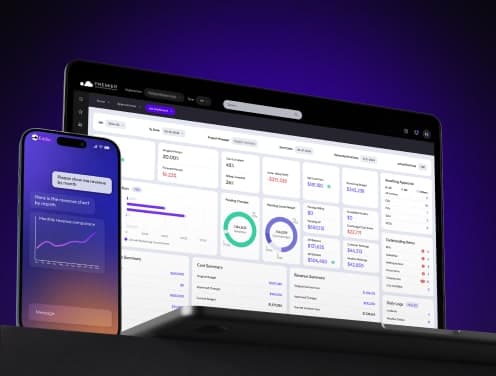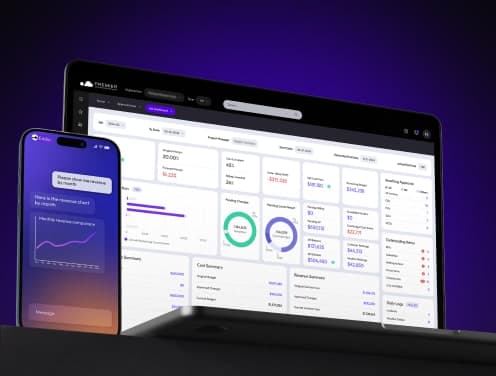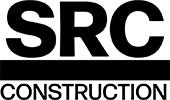
How AI is Revolutionizing Construction Estimates: What You Need to Know
AI technology revolutionizes how construction professionals create project bids. Traditional estimators relied on pen and paper calculations. This manual approach proved slow and error-prone - studies reveal that all but one of these spreadsheets contain 1% or more formula errors.
Construction teams now face significant challenges. The industry needs nearly 500,000 workers, which results in higher costs, delays, and exhausted teams. A single manual project estimate consumes eight hours. Preconstruction professionals dedicate 13.4 hours each week to research and data analysis.
This piece explores AI technology's impact on construction estimates. You'll learn effective ways to implement these tools and balance automation with expertise to secure more bids and save time.
Why Construction Estimating Needs a Tech Upgrade
Traditional construction estimating methods no longer work. Highlighters, rulers, and gut instinct can't guide project budgets reliably anymore. Modern construction projects just need accuracy, speed, and informed decisions that old approaches can't deliver.
The cost of outdated methods
Manual takeoffs and old-school estimating waste time and create major errors. Construction firms using traditional methods spend up to 50% of their bidding cycle on takeoffs alone. Your valuable time gets spent counting and measuring instead of working on value engineering and competitive pricing.
These old processes aren't just slow – they put finances at risk. Estimator mistakes with manual calculations ripple through the entire project. One wrong quantity measurement or material price can destroy budgets and profit margins. A mid-sized Portland construction firm underbid a commercial project by $400,000 because they missed items in mechanical and sitework divisions.
Accuracy has never been more crucial. Research from the International Journal of Innovation, Management and Technology shows poor cost estimation as the biggest problem behind project overruns. Estimators don't deal very well with maintaining precision on complex projects without reliable digital tools.
Labor shortages and time pressure
Construction's talent crisis directly affects estimating quality. The sector needs nearly 500,000 workers, which causes higher costs, delays, and team burnout. About 88% of construction firms can't find qualified workers.
This shortage creates serious problems for estimating departments:
- Experienced estimators keep leaving: Over 20% of construction workers are 55+ years old, and they're retiring faster than they can be replaced
- The expertise gap grows wider: The National Center for Construction Education and Research expects 41% of the construction workforce to retire by 2031
- Remaining estimators handle more bids with less help
Estimating deadlines get tighter too. Estimators must provide exact costs quickly during competitive bidding, often under extreme time constraints. Mistakes happen more often in this rushed environment - especially with manual methods that can't handle the workload.
Research proves that too much schedule pressure hurts productivity. Studies show excessive time pressure makes people cut corners, create defects, and work out of sequence. This starts a dangerous cycle where rushed estimates cause project problems that lead to more rushed estimates.
The need for faster, smarter bids
Construction companies won't stay competitive using outdated estimating methods. Modern projects need well-laid-out, reliable, and quick systems that make planning more predictable. Estimators need tech support to handle rising material costs, changing labor rates, and complex specifications.
AI in construction estimating solves these challenges by automating tasks that once needed manual effort. AI tools create estimates faster and more precisely than traditional methods with their high error risk. This technology helps construction teams win more bids through accuracy rather than low prices.
Smarter bids create better business results. Construction technology lets professionals make digital takeoffs that capture every project detail exactly. Advanced software also helps collect and analyze past project data, so estimators can develop precise cost forecasts and reduce budget risks effectively.
The reality? Construction estimating technology isn't optional anymore – it's crucial to survive in today's competitive market. Modern software tools like AI-powered estimating platforms help construction firms overcome labor shortages, tight deadlines, and complex projects while improving both speed and accuracy.
How AI-Assisted Estimating Works
AI-powered estimating tools work much simpler than you'd expect, even with sophisticated technology running behind the scenes. These tools turn what used to be days of work into minutes and create more accurate estimates with minimal manual effort.
Uploading and analyzing plans
The process starts quite simply. You upload your construction project files to a cloud-based platform - usually PDFs of architectural plans, specifications, and drawing sets. Modern AI systems can work with many file types, from CAD files to scanned documents and hand-drawn sketches.
Your plans start processing as soon as they're uploaded. Traditional estimators spend 45-60 minutes reviewing each plan page, but AI estimating software completes this task in under a minute. One AI system needed just 6 minutes to process more than 40 sheets. Construction professionals can now spend time on strategic decisions rather than tedious measurements.
Pattern recognition and symbol detection
Neural networks trained on millions of architectural drawings power the AI's pattern recognition capabilities. These networks automatically spot every line, symbol, and dimension in the plans. The system identifies construction elements like walls, doors, flooring, and other materials without human input.
Machine learning algorithms like YOLOv7 and Faster R-CNN have revolutionized symbol detection in construction estimating. Research shows these models excel at recognizing various construction symbols with remarkable precision. Togal.AI's software proves this by detecting, measuring, comparing, and labeling project spaces and features within seconds.
The technology relates symbols to their environment. The AI examines surrounding areas to understand their meaning and parameters. On top of that, it pulls out drawing set details such as sheet names, numbers, dates, and the physical layout of information.
Learning from historical data
These AI construction estimating tools grow smarter with each project. The systems fine-tune their predictions by processing more data. Algorithms learn to spot trends, connections, and unusual patterns in evidence-based datasets.
This learning happens through several ways:
- Historical Data Comparison – The AI spots differences between original estimates and final costs to improve future calculations
- Pattern Recognition – The system learns about cost trends, labor issues, and material price changes from previous projects
- Predictive Modeling – Machine learning algorithms predict costs based on project size, complexity, location, and available resources
The numbers tell the story. A study of ten machine learning models for construction cost prediction found that HistGradient Boosting performed best with testing datasets. These systems combine data from past projects, market trends, supply chains, and economic factors to give a complete picture of what drives project costs.
AI estimating tools create more accurate predictions through constant learning. They help teams learn about potential risks and their effect on costs by finding patterns and connections. This gives construction teams powerful insights into future projects based on past performance.
Choosing the Right AI Estimating Tool
AI estimating software selection depends on your company's needs and infrastructure. The market offers many options with different features, deployment models, and compatibility levels. You'll find the right fit by balancing technical requirements with usability and cost.
Cloud-based vs on-premise tools
Choosing between cloud-based and on-premise AI estimating tools is a key decision that affects your long-term operations. Cloud-based solutions work through providers like AWS, Google Cloud, or Microsoft Azure. These tools give you better accessibility and make setup easier. Your team can access estimates from any location with internet connectivity, which makes team collaboration natural.
Cloud platforms cost less upfront since you don't have to buy expensive hardware. They also let you scale up during busy times and access state-of-the-art AI hardware without big investments.
On-premise solutions install directly in your organization's infrastructure. This option lets you retain control over hardware setup and optimization. Construction firms that have strict data security requirements often prefer this approach because sensitive project data stays within their environment.
The cost structure is different between these approaches. Cloud tools usually follow subscription models that cost $30 to $250 monthly for each estimator. On-premise solutions need substantial upfront investment but might cost less over time for stable workloads.
Many organizations end up choosing hybrid approaches. They use cloud platforms for resource-heavy tasks while keeping sensitive operations in-house. This balanced approach can cut cloud costs by up to 50% while maintaining data control.
User interface and ease of use
The success of AI estimating software depends on how well your team can use it. Construction professionals like easy-to-use interfaces that don't require deep technical knowledge. Even the most advanced AI features become useless if estimators can't direct the system properly.
These usability factors matter during evaluation:
- Time needed to learn and onboard
- Training resources and support documentation
- Interface design and navigation structure
Cloud-based platforms are usually easier to use because they're built for modern web interactions. They come with tutorials, customer support, and automatic updates. Features like drag-and-drop and AI suggestions help refine estimates without requiring extensive software expertise.
The ideal AI estimating tool combines powerful features with practical usability. Choose solutions that fit your current workflows, meet your security needs, and offer interfaces your team can learn fast. A careful review of these factors will help you find AI estimating technology that boosts your construction bidding process.
Top Benefits of Using AI in Estimating
AI in construction estimating brings real advantages that boost your bottom line. Here's a look at the measurable benefits your construction business can expect from this technology.
Time savings on takeoffs
AI-powered takeoffs speed up what used to be the most time-consuming part of estimation. Research shows preconstruction professionals spend about 13.4 hours weekly to research and analyze data. AI completely changes this picture.
This speed upgrade reshapes the scene. The combination of BIM data with AI-powered takeoff tools cuts estimating time by up to 30% and quantity takeoff time by over 50%. Estimators can now focus on tasks that grow the business.
One estimator explains: "If it's taking me 10 minutes to do a wall takeoff, Boost has it completed in 30 seconds to a minute. That's very fast compared to what I can do".
Reduced errors and rework
Manual estimation methods lead to mistakes that flow throughout projects. In fact, 88% of all spreadsheets have at least 1% errors in their formulas. Small inaccuracies create big problems down the line.
AI tools remove many human errors through automation. A report shows AI-driven estimating reduces errors by up to 90% compared to manual methods. Better accuracy prevents budget overruns and change orders that cut into profits.
AI reduces errors by:
- Finding discrepancies in quantity data automatically
- Removing calculation mistakes in material counts and measurements
- Keeping consistency in complex projects
A contractor using an AI platform cut bid preparation time from 6 hours to 90 minutes while improving accuracy. This mix of speed and precision gives your company an edge over competitors.
More accurate cost predictions
AI helps construction teams predict costs with unmatched accuracy. The software learns from historical project data to make better future estimates.
Machine learning algorithms help by:
- Getting up-to-the-minute updates on material pricing and labor rates
- Learning from past and current data to spot price changes
- Warning about supply chain risks before they affect your project
Research on machine learning models for construction cost prediction shows HistGradient Boosting performs best. The result? AI-driven cost estimation cuts project overruns by up to 15%, a huge improvement for large-scale projects.
Improved collaboration
AI estimating tools work faster and better with your whole team. These platforms let project stakeholders work together in real time, making the estimation process transparent.
This team-based approach helps in several ways:
AI makes sharing information easier and provides evidence-based insights. Teams save time by avoiding switches between different tools, studies show construction teams waste 30% of their time doing this.
Many AI estimating tools work smoothly with existing construction management software. This connection brings field workers, office staff, and decision-makers together.
AI helps construction teams create more competitive bids.
Trades and Teams That Benefit Most
AI estimation technology benefits the construction industry, but some trades see bigger improvements than others. Specialty contractors who handle detailed quantity takeoffs find AI tools especially helpful.
Drywall and painting
Drywall and painting contractors spend countless hours on takeoffs. AI tools have changed everything by handling the most time-consuming parts of estimation.
The numbers speak for themselves when it comes to drywall contractors. AI software reduces takeoff time by 90%, which lets teams submit twice as many bids with the same staff. One contractor doubled annual revenue from $6 million to $12 million after using AI tools to speed up bidding.
The technology calculates all drywall quantities automatically:
- Panel quantities
- Framing requirements
- Insulation needs
- Taping and mudding specifications
Painting contractors see the same benefits with AI takeoff software. These tools figure out wall square footage, ceiling area, surface types, and primer needs without anyone tracing site plans. This saves painters 90% of their takeoff time and doubles their bid capacity with no extra staff.
A painting contractor puts it this way: "We're bidding more than ever now that we're not spending 20-30 hours per takeoff".
Framing and flooring
Flooring estimators used to spend days calculating materials from complex blueprints. AI-powered takeoff software now turns this job from days into hours.
The impact shows in the numbers. Contractors who use AI flooring tools cut their estimation time by 70%. Their material waste drops by up to 15% thanks to better measurements, which boosts profit margins.
AI really shines with complex flooring projects. To name just one example, see how contractors with intricate patterns use AI to turn elaborate designs into exact material orders. The software scans blueprints and identifies flooring areas, dimensions, and material needs.
The AI creates Excel-ready takeoffs with detailed calculations for square footage, material quantities, and labor needs. This accuracy helps throughout the project.
General contractors and estimators
General contractors have a tough job coordinating estimates between trades and scopes. AI estimation tools help them bid faster with complete quantity takeoffs that cover every project aspect.
The technology helps GCs:
- Process multiple drawing sets simultaneously
- Standardize takeoff approaches across trade partners
- Generate structured material quantities for all suppliers
Estimators save 15-20 hours weekly and can handle more bids. This extra time lets them focus on pricing strategy, vendor outreach, and proposal review, the work that wins projects.
Subcontractors win more work from general contractors by delivering fast, accurate takeoffs. Both GCs and their trade partners can work together better when they share data and use consistent estimation methods.
Trades that measure surface areas repeatedly, like drywall, painting, and flooring, benefit most from AI estimation technology right now. In spite of that, as these tools grow more sophisticated, even complex specialty trades will find AI valuable to bid faster and more accurately.
Balancing AI with Human Expertise
Construction estimating will always need human expertise, despite all the technological advances. Machines won't replace estimators. Instead, estimators need better tools to make better decisions.
AI as a support tool, not a replacement
AI works best as your assistant, not your replacement. Construction estimating AI takes care of repetitive tasks. This gives you more time to focus on strategic decisions, negotiations, and client communication, areas where human judgment and relationship skills matter most.
One estimator explains it well: "AI can't do everything I do... It allows me to spend more time on meaningful tasks like cultivating customer relationships, procuring better pricing, and visiting project sites".
Some people worry about losing their jobs. Industry experts believe AI will increase, not replace, human expertise. Construction professionals who understand AI become more valuable and sought-after.
Tasks that still need human judgment
Human insight beats algorithms in several key areas:
AI can't spot a poorly written spec section or negotiate with subcontractors. A machine can't tell when a job feels "off" because of missing site logistics or local labor shortages.
Regional expertise proves vital. Construction costs change by location due to labor availability, regulations, supply chains, and climate. AI can analyze numerical trends, but experienced estimators know regional quirks that historical data might miss.
Risk assessment needs human intuition. Construction projects face many risks that are hard to calculate: weather events, political changes, site constraints, and stakeholder relationships.
Training teams to work with AI
Your team needs a thoughtful approach to feel comfortable with AI. Building trust and confidence requires:
- Giving estimators override control
- Creating clear audit trails
- Adding risk flags that show areas needing human attention
Training makes a big difference. Complete programs that teach estimators AI-assisted workflows lead to success. Many construction firms now run hands-on workshops to help teams use AI tools with confidence.
The right balance prevents two extremes, avoiding helpful technology and relying too much on it. Note that technology should improve human expertise. Regular checks help maintain this balance.
Modern construction estimating works best when AI's processing power combines with human insight. This partnership creates better estimates than either could achieve alone.
What’s Next for AI in Construction Estimating
AI in construction estimating keeps growing as technology advances. New applications reshape how construction professionals handle project budgeting and planning.
Sustainability and carbon tracking
AI tools now include carbon footprint calculations in the estimation process. These systems automatically calculate embodied carbon in materials, operational emissions, and sustainability metrics while generating cost estimates. Construction teams can assess both financial and environmental effects at once when comparing design options or material choices. Contractors can meet strict environmental regulations and sustainability requirements without extra time spent on separate carbon analyzes.
More advanced predictive analytics
Next-generation AI estimating tools provide deeper insights into project risks and opportunities. These systems link live weather forecasts, supply chain data, labor availability metrics, and economic indicators to create dynamic cost projections. AI doesn't just show today's costs - it predicts costs three months ahead based on market conditions. Premier’s construction accounting software shows this trend with features that let contractors plan for various cost scenarios. Teams can spot potential savings before breaking ground.
Wider adoption across project sizes
AI estimating was mainly used by larger contractors on major projects. The technology costs have dropped and user interfaces have become simpler. Small construction businesses have started to implement these tools. Cloud-based solutions with budget-friendly subscriptions make sophisticated AI features available to contractors of all sizes. More construction professionals recognize that AI estimating tools help them compete against larger firms. Teams can produce faster, more accurate bids without expansion.
Conclusion
AI has changed the way construction professionals handle project estimating. This piece shows how these technologies reduce takeoff time and deliver better accuracy than manual methods ever could. The old way of spending eight hours on a single estimate seems ancient now that contractors can process complex takeoffs within minutes.
The practical benefits stand out clearly. AI doesn't just make workflows faster - it changes them completely. Construction teams using these tools can bid on more projects, spot errors early, and predict costs more accurately. They also save countless hours previously spent on tedious calculations.
Finding the right balance is vital. The best outcomes happen when AI takes care of repetitive tasks while construction professionals use their judgment for nuances that machines can't understand. One contractor mentioned that AI creates opportunities to build relationships and think strategically - the most valuable parts of an estimator's job.
Drywall, painting, and flooring trades see dramatic advantages. Companies often double their bidding capacity without needing extra staff. General contractors also benefit from faster, standardized takeoff processes in multiple areas.
Premier Construction Software shows how construction ERP systems combine smoothly with AI estimating capabilities. Contractors can simplify their operations from the first bid through project completion. This end-to-end connection makes the entire construction process more efficient.
The road ahead looks bright. AI estimating will soon calculate carbon footprints alongside costs, helping contractors meet sustainability goals effortlessly. Advanced predictive analytics will forecast material prices based on market conditions and supply chains.
Cloud options now make these tools available to smaller contractors at affordable prices. This means businesses of all sizes can create professional, accurate estimates that match larger firms.
AI estimating has become essential in construction. While technology will keep evolving, one thing's certain - construction professionals who blend smart AI tools with their expertise will win more bids, finish projects profitably, and keep up with trends in this competitive industry.





















